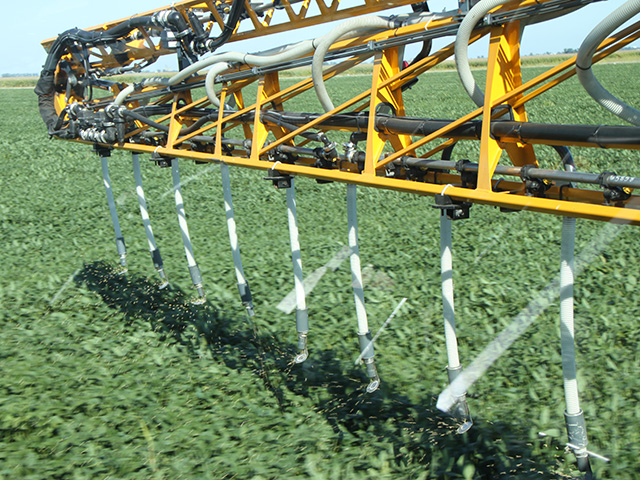Cover Crops Help Growers in Wet Season
National Survey Shows Farmers Benefit From Planting Cover Crops
OMAHA (DTN) -- Though a wet 2019 planting season led to producers foregoing planting millions of acres of crops, many farmers found ways to plant either early or on time into green cover crops, according to a report released Wednesday outlining results from the 2019-2020 National Cover Crop Survey.
The latest survey of 1,172 farmers by USDA's Sustainable Agriculture Research and Education program, Conservation Technology Information Center and American Seed Trade Association, found that more than 90% of farmers reported cover crops allowed them to plant earlier or at the same time as non-cover-cropped fields.
The 2019 planting season between May 2018 and April 2019 was the wettest year on record. Just 67% of corn and 39% of soybeans were planted by June 2, 2019.
USDA estimated flooding delayed or prevented planting on 19 million acres of cropland in 2019.
About 71% of survey respondents reported improved weed control from planting into green cover crops, and 27% said early season diseases were better than a conventionally managed cover crop.
"Many growers said voles and slugs weren't their big worry (though a few others said they had trouble with them)," the report said, "but quite a few highlighted challenges with cutworms when planting green."
Six in 10 survey respondents said planting green was either simpler or similar in complexity in terms of cover crop and cash crop management compared to terminating cover crops earlier. About 68% of growers said planting green helps to manage soil moisture.
"Though a comparable number of corn and soybean growers reported employing the practice, soybeans were by far the most popular crop to plant green, with 318 of the 417 total responses," the report said.
A whopping 79% of growers said last year's wet weather delayed planting cash crops in their county.
"It is important to note that the extremely wet spring of 2019 may have increased the incidence of planting green by interfering with cover crop termination and forcing growers to hurry to plant their cash crops when soils were even close to dry enough," the report said.
P[L1] D[0x0] M[300x250] OOP[F] ADUNIT[] T[]
"It was interesting to see that 78% of the cover crop users did not have a prevent plant claim -- reflecting failure to seed a cash crop before a final planting date specified by crop insurance rules -- despite the challenging growing season. Among those who did, 36% said prevent plant was more common in conventionally managed fields compared to cover cropped fields; 55% said the incidence of prevent plant was equal regardless of whether the field was cover cropped."
YIELD GAINS FOR 2019
The drought year of 2012 showed the biggest yield increases from cover crops, according to the report. Farmers surveyed in 2019 reported modest boosts in soybean, corn and wheat yields of 5%, 2% and 2.6%, respectively.
"While farmers appreciate the yield benefits of cover crops, additional questions in the survey clearly indicate that they are also motivated by cover crops' abilities to deliver other benefits, like weed control, soil health, erosion control, livestock grazing and so many others," the report said.
When it comes to fertilizer savings, 49% of corn producers reported reduced fertilizer costs, as did 41% of soybean producers, 43% of wheat farmers, and 53% of cotton producers.
A similar pattern emerged with herbicide savings. The survey found about 71% of cotton farmers had reduced herbicide costs, followed by corn at 39%.
Overall, American farmers increased cover crop acreage by about 50% between USDA's 2012 and 2017 Ag Census.
The report said there were about 10 million cover crop acres on 133,500 farms in 2012 and more than 15 million acres on 153,400 farms in 2019.
CORN COVER CROPS
Survey report authors said the results showed corn farmers who also planted cover crops saw about a 3.5-bushel-per-acre increase in yields compared to farmers who didn't plant cover crops.
"Among the benefits of cover crops that nearly half the respondents (239 of 492, or 49%) reported is a savings in fertilizer costs in their corn crop after using cover crops for at least three consecutive years," the report said.
"Though the largest number of respondents (65, or 13.2%) reported a $6- to $10-per-acre fertilizer cost savings, the responses ranged from 4.9% (24) of farmers reporting $16 to $20 in savings to 11% (54) reporting benefits of $1 to $5 per acre and 10.8% (53) more than $20 per acre."
Corn producers also reported some savings in herbicide costs from using cover crops. Savings ranged from $1 to $5 per acre to $21 or more per acre, according to the survey report.
SOYBEANS AND COVER CROPS
On soybean crops, the survey found producers also planting cover crops averaged about 54 bushels per acre, while those without cover crops averaged about 52 bushels.
On fertilizer, 41% of farmers reported cost savings following cover crops.
"A significant majority -- 266 respondents, or 57.8% -- reported no savings or losses in soybean fertilizer costs following soybeans," the report said.
Cover crops lowered herbicide costs in soybeans for two-thirds of the respondents. The most common level of savings was $6 to $10 per acre.
Todd Neeley can be reached at todd.neeley@dtn.com
Follow him on Twitter @toddneeleyDTN
(c) Copyright 2020 DTN, LLC. All rights reserved.






